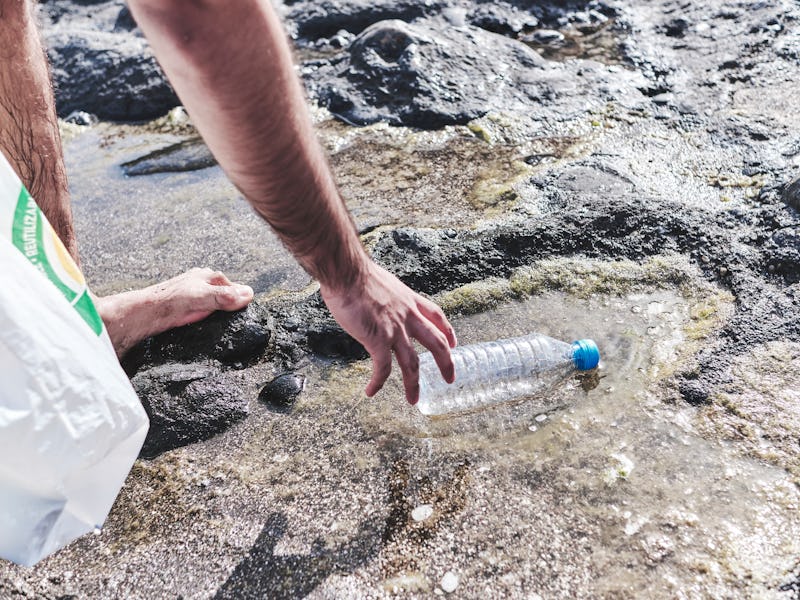Plastics could enrich the world simply by no longer being plastic
Time to embark on a new, cleaner chapter in our dirty love affair with polyethylene.

In 1933, humans embarked on an ill-advised and down-right dirty love affair.
The object of our affection? Polyethylene. First discovered to have practical applications in 1933, this is the scientific name for the most common type of plastic used today. It is so ubiquitous, it was once hailed as the “all-star plastic” for its wide variety of uses.
Now over 100 million tons of polyethylene are produced every year — and while it absolutely has its uses, it also invariably winds up in the trash. Plastic is a catch-22 kind of material. It is cheap, versatile, and resists degradation, and so is useful in making everything from water pipes to headphones. But that lack of degradability means it is an ever-increasing waste problem, with over 13 million metric tons entering the ocean each year. In the United States alone, more than 14 million tons of plastic become waste, according to the Environmental Protection Agency.
It does not need to be this way.
Rather than force people to change their lifestyles to eradicate polyethylene, a team of researchers has come up with a new strategy: instead of using less, polyethylene itself could become a resource to make more chemical compounds. Essentially, we'd be upcycling instead of recycling, they say.
The science behind this counterintuitive proposal is outlined in a new paper published Thursday in the journal Science.
The way it would work is this: Polyethylene would be converted to liquid chemicals that are used in a variety of common household items and appliances, like dish detergent or refrigerator coolant. Chemicals currently used in fridge coolants or air conditioners are frequently cited as sources of greenhouse gases, including hydrofluorocarbons. So while this idea isn't a perfect, zero-emissions solution to the problem of these chemicals, it is a start — and it is likely sustainable.
In an accompanying editorial, also published in Science, Utrecht University materials scientist Bert Weckhuysen writes their development could “pave the way toward a circular plastics economy, in which plastic is not considered waste but rather a valuable raw material.”
All that waste could turn into something else in your home.
Testing the theory — The team used a polyethylene bag similar to that you get in a grocery store and a plastic bottle cap to test their method. They used two kinds of chemical reactions to alter the plastic. The first is hydrogenolysis, in which carbon–carbon bonds in the material are broken down by hydrogen, and the second is aromatization, which increases compound stability and is used in oil refining. Again, this process can give off unwanted greenhouse gases.
“A delicate balance between these two catalytic reactions must be maintained to avoid the unnecessary production of less valuable gases,” Weckhuysen explains.
While they did successfully convert the plastic into the desired chemicals, they discovered problems with their method, too. More hydrogen was created in the process than expected, and the amount of aromatics produced was also greater, according to the study.
Price tag — Chemical recycling of this kind suffers from competition — a lack of incentives and low-cost alternatives make it hard to break through, Weckhuysen says. So the challenge then becomes how to add value to the plastics. That is what this team attempts to do with their strategy — but it needs work.
One of the crucial elements of the method, the catalyst, is prohibitively expensive. Susannah Scott is distinguished professor of chemistry at University of California, Santa Barbara and co-author of the study. She tells Inverse that the current price for their catalyst is around $2000 per ton. She and her team estimate “the potential revenue in a continuous 250 ton/day process could be $800 per ton of plastic waste.” That low revenue just doesn't make this a cost-efficient proposal, she notes.
“The most important cost driver involves the catalyst. In principle, it can be recovered and reused indefinitely, but there are inevitably small losses,” Scott says. But there is money to be made from pursuing this kind of work further, she adds.
“The global market for linear alkylbenzenes is worth nearly $9 billion,” she tells Inverse (alkylbenzenes is the scientific name for the chemicals the process produces). With a market that big, the potential to make a dent with a world’s worth of plastic is enough incentive to keep the hunt for a cheaper catalyst alive, she says. It will be worth it — for both the health of the economy, and for the world.
Abstract: The current scale of plastics production and the accompanying waste disposal problems represent a largely untapped opportunity for chemical upcycling. Tandem catalytic conversion by platinum supported on g-alumina converts various polyethylene grades in high yields (up to 80 weight percent) to lowmolecular-weight liquid/wax products, in the absence of added solvent or molecular hydrogen, with little production of light gases. The major components are valuable long-chain alkylaromatics and alkylnaphthenes (average ~C30, dispersity Ð = 1.1). Coupling exothermic hydrogenolysis with endothermic aromatization renders the overall transformation thermodynamically accessible despite the moderate reaction temperature of 280°C. This approach demonstrates how waste polyolefins can be a viable feedstock for the generation of molecular hydrocarbon products.